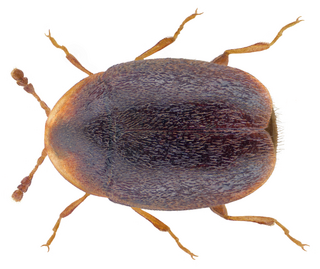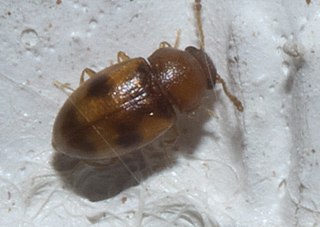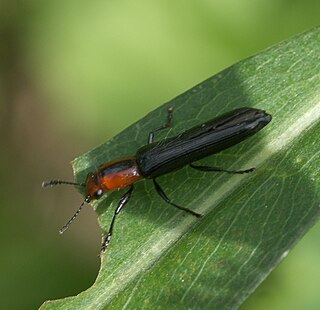
Corylophidae is a family of minute hooded beetles, sometimes called minute fungus beetles, in the superfamily Coccinelloidea. There are about 18 genera and at least 120 described species in Corylophidae. They feed on microfungi such as molds, and are often found associated with bark, as well as in leaf litter and other decaying vegetation. In older literature, the family name was often given as Orthoperidae.

Cryptophagidae is a family of beetles with representatives found in all biogeographic realms. Members of this family are commonly called silken fungus beetles and both adults and larvae appear to feed exclusively on fungi although in a wide variety of habitats and situations, such as rotting wood and shed animal fur and feathers. These beetles vary from about 1 to 11 millimeters long, and usually have an oval body shape with a slight "waist".

Erotylidae, or the pleasing fungus beetles, is a family of beetles belonging to Cucujoidea containing over 100 genera. In the present circumscription, it contains 6 tribes and 10 subfamilies. In other words, the narrowly circumscribed Erotylidae correspond to the subfamily Erotylinae in the definition sensu lato. There are doubts on the monophyly of lower ranked taxa within Erotylidae, with further phylogenetic studies requiring better sampling and studies of unexplored character sets, for example the metendosternite and penile flagellum, which are generally lacking detailed morphological studies within the Coleoptera literature. The Eroytlina taxonomy is based on traits such as their different colors and not off morphological differences like mouthparts, thorax, and abdominal terminalia (Pecci-Maddalena).

Endomychidae, or handsome fungus beetles, is a family of beetles with representatives found in all biogeographic realms. There are around 120 genera and 1300 species. The family was established based on the type genus Endomychus, a genus erected in 1795 by Panzer which was applied to a species that Linnaeus called Chrysomela coccinea. As the common name suggests, Endomychidae feed on fungi. Crowson, in his influential treatment of the beetles, placed the family within the Cucujoidea. They have a tarsal formal of 4-4-4 or 3-3-3 and the wings lack a closed radial cell. The second antennal segment has a sensory appendage that is as long as the third antennal segment. The family has also been grouped with the Coccinellidae in a group called the Trimera for having pseudotrimerous tarsi. A 2015 molecular phylogeny study found that the Cucujoidea were found to be non-monophyletic and the Endomychidae was refined with the removal of the Anamorphinae from within the family and elevated to the status of a full family, Anamorphidae. Mycetaeinae and Eupsilobiinae were also found not to belong within the clades of the core Endomychidae, and likewise reclassified into the families Mycetaeidae and Eupsilobiidae.

Eucradinae is a subfamily of death-watch and spider beetles in the family Ptinidae. There are at least 5 genera and about 18 described species in Eucradinae.

Tritomini is a tribe of pleasing fungus beetles in the family Erotylidae. There are about 7 genera and at least 30 described species in Tritomini.
Europini is a tribe of root-eating beetles in the family Monotomidae. There are about 8 genera and at least 40 described species in Europini.
Dichelonychini is a tribe of beetles, known as May beetles and Junebugs, in the family Scarabaeidae. There are at least 3 genera and 60 described species in Dichelonychini.

Toramus is a genus of pleasing fungus beetles in the family Erotylidae. There are about nine described species in Toramus.

Xenoscelinae is a subfamily of pleasing fungus beetles in the family Erotylidae. There are about 8 genera and 12 described species in Xenoscelinae.

Nitidulini is a tribe of sap-feeding beetles in the family Nitidulidae. There are about 10 genera and at least 20 described species in Nitidulini.

Pharaxonotha is a genus of pleasing fungus beetles in the family Erotylidae. There are at least three described species in Pharaxonotha.

Atomariini is a tribe of silken fungus beetles in the family Cryptophagidae. There are about 5 genera and at least 70 described species in Atomariini.

Attagenini is a tribe of carpet beetles in the family Dermestidae. There are at least 4 genera and 20 described species in Attagenini. Attagenini was previously considered a subfamily of Dermestidae called Attageninae, but was reduced in rank to tribe in 2003.
Haematochiton is a genus of pleasing fungus beetles in the family Erotylidae. There are at least three described species in Haematochiton.
Ciini is a tribe of minute tree-fungus beetles in the family Ciidae. There are at least 30 genera in Ciini.

Acropteroxys is a genus of lizard beetles in the family Erotylidae. There are at least two described species in Acropteroxys.
Dasydactylus is a genus of lizard beetles in the family Erotylidae. There is one described species in Dasydactylus, D. cnici.
Langurites is a genus of lizard beetles in the family Erotylidae. There are at least three described species in Langurites.

Anobiini is a tribe of death-watch beetles in the family Ptinidae. There are at least 6 genera and 20 described species in Anobiini.
















